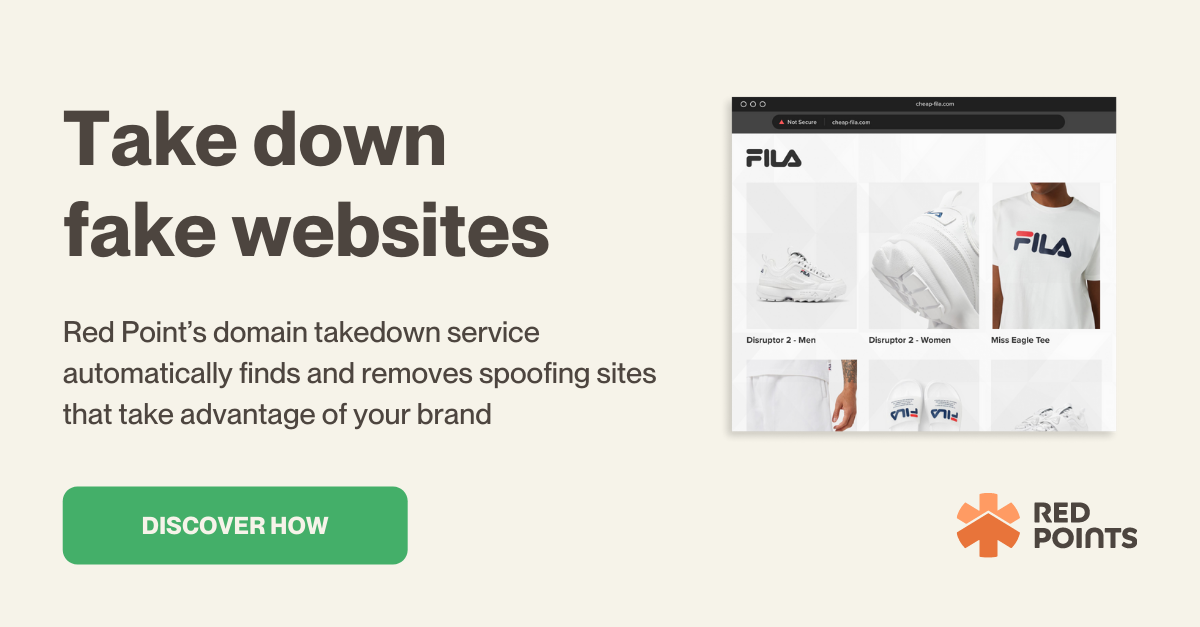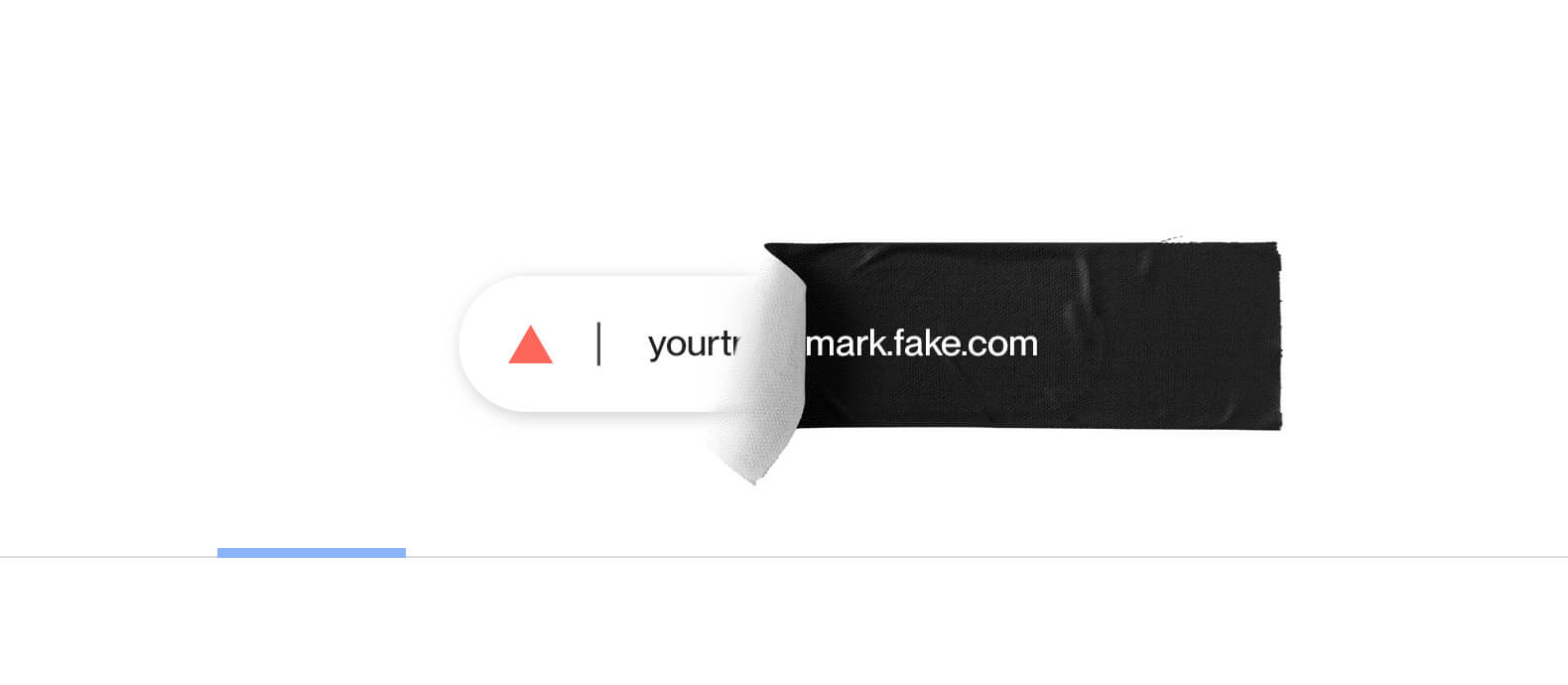Digital pirates are constantly experimenting with new ways to steal from legitimate businesses and mislead unsuspecting consumers. From email phishing to malware distribution, there are many scams that have proven very effective for bad actors intent on taking advantage of innocent people and businesses.
URL spoofing is a common tactic used by scammers. This scam plays with trust and gets people to click on links that they believe are safe to use. With URL spoofing scammers are able to steal information, direct people to dangerous webpages, and get unsuspecting web browsers to believe they are interacting with legitimate businesses.
In this blog, we’ll be delving into URL spoofing and exploring how you can prevent it, by focussing on a few topics including:
- What is URL spoofing?
- Most common examples of URL spoofing
- How does URL spoofing impact businesses?
- How can businesses prevent URL spoofing?
- How does Red Points stop URL spoofing?
What is URL spoofing?
URL Spoofing, or domain spoofing, is when a scammer uses a fraudulent link to pose as a legitimate website or recreates an entire fake website in order to steal from or mislead consumers. It is a common tactic of many digital pirates that is simple to carry out but potentially very damaging to the victim. URL spoofing is a kind of phishing scam that uses deception to get recipients to give over information.
Today 90% of corporate security breaches are caused by some kind of phishing attack. Therefore it is vital for all businesses to understand the nuance of phishing strategies like URL spoofing so that they can avoid them and protect their brand from online scammers.
Most common examples of URL spoofing
- Misspelled domain name
Hackers only need to change one character in an URL to register a new domain. Therefore a common tactic for digital pirates is to misspell a popular domain name by one character or have a slightly different Top Level Domain (TLD) which is often “.com”, but a fake might use “.org” or “.us”. People tend to skim over links. They are unlikely to spot such a small change and they will click without a second thought.
Misspelled links are commonly included in phishing emails. A scammer might send you an email with a link in it asking you to confirm your payment details. The link included in the email address of the sender will be very similar to one from a legitimate website but perhaps just misspelled.
If you take time to read every email you get in detail then this misspelling will be easy to spot, but these scammers are counting on the fact that most people don’t take the time to notice the details.
- Links hidden behind words or buttons
One of the most well-used tactics in a scammers’ playbook is to send emails or messages masquerading as a legitimate source and hide dangerous links behind words or buttons.
This is a lazy ploy that is becoming less effective over time. More people are aware that they can simply hover over or right-click a hyperlinked word or button and see the URL. If the URL looks strange then most people simply won’t click on it. However, this website spoofing tactic remains in use today because it still occasionally works and it helps URL spoofers deliver their malicious content.
- Using short URLs
A common way to spoof URLs is to shorten them. This is a tactic that is often used on social media sites that limit the number of characters per post. It is also used in text messages where short links are more convenient and less suspicious. Short URL links are also easier to hide and it is very difficult to tell where they might lead you until you click on them.
- Added keywords
Scammers also add keywords to URLs to help them trick people into clicking. For example, fraudsters might input words like “sales” or “giveaways” in URLs to entice browsers and try to appear as legitimate links.
This is a common tactic with fake websites because it is an easy way of leveraging a brand’s real name in the core of a new fraudulent domain name. Additionally, scammers often target users that publicly sign up for giveaways on social media. So, if your business does giveaways you need to be mindful of these kinds of schemes.

How does URL spoofing impact businesses?
URL spoofing has the ability to interfere with your daily business activity and impact your brand in a variety of ways.
- Damages customer experience and brand community
Firstly, URL spoofing will have a negative impact on your customer experience and your online brand community. An important part of customer experience is trust. Customers that fall victim to URL spoofing that targets your brand will usually then have trouble trusting any links associated with your business in the future. They will feel less secure on your website and it will be difficult to create a genuine connection with them through your online interactions.
- Ruins brand image
Secondly, URL spoofing impacts your overall brand image. If your business is constantly targeted by scammers and website impersonation it will reflect poorly on your brand’s security and protection policies. If customers know that your scammers often use URL spoofing to take advantage of your business, your brand’s image will diminish.
- Revenue losses
Thirdly, URL spoofing has the potential to have a negative net impact on your revenue. If many customers are falling victim to URL spoofs associated with your business then they may be deterred from spending money on your products and services. This will have a serious impact on your revenue streams and will eventually affect your business’s ability to grow.
How can businesses mitigate the impact of URL spoofing?
So, what can you do to mitigate the impact of URL spoofing? Businesses can always do more to defend against digital scammers and online fraudulence.
1. Register your intellectual property
One of the first steps you should take is to register your domain names as intellectual property(IP). This will provide your business with robust legal protection if any URL spoofers try to take advantage of your brand’s URLs. While domain names do not have any inherent intellectual property value they can be trademarked as an intangible asset. As long as it is a domain name capable of distinguishing and identifying services or goods from others you can register it as a trademark and protect it under IP law.
2. Claim similar URL names
Another proactive step you can take is to claim URL names that have a similar spelling format to your own URL. With this method, you limit scammers’ ability to take advantage of your URL name. You can also use these claimed URL names to reroute anyone who searches for them to your official site. These steps are very effective at limiting the kind of URL spoofing that may impact your brand.
3. Domain name monitoring
Regularly monitor domain registrations. By monitoring domain name registrations on a daily basis and looking for variations of your company’s domain name you will be able to identify any unauthorized or fraudulent registrations. This will help you keep track of any URL spoofing and prevent frequent offenders from damaging your business.
4. Engage in brand protection
You should also monitor online platforms and social media networks for accounts or pages that impersonate your brand. The amount of people using social media means that there are many opportunities for scammers. Therefore you should engage in brand protection across a variety of social media sites to ensure that consumers are not being misled by URL spoofers.
How does Red Points stop URL spoofing?
Red Points’ Domain Takedown Service will help you stop URL spoofing and protect your brand from online scammers. URL spoofers are always trying to steal your content, take advantage of your reputation and attack unwitting online consumers. We’ve created a service that tackles these problems and reduces the ability for URL spoofing to impact your brand.
Our website takedown solution keeps your business and customers safe in three simple and effective steps:
- Monitor and detect
We monitor the web 24/7 with an automated bot-powered to ensure that we detect and track URL spoofing wherever it may appear online. The whole process is both thorough and precise.
Automation allows you to detect many possible infringements in a short amount of time. At the same time, machine learning also allows us to make each search more targeted than the last.
- Review and validate
Through the monitoring and detection process, we form a view of the potential URL spoofers and bad actors. We then add these to a log of detections that can be accessed within our platform. You will then have the opportunity to review and validate a detection to confirm its legitimacy. You can also use our smart rules to set up an automated validation process based on the rules and parameters you create.
- Enforce and takedown
Then you can immediately start to enforce against these URL spoofers and remove any content that puts your customers at risk. We will act on your behalf to begin the takedown process by leveraging data and kickstarting the legal process.
Following enforcement you will be able to review the whole process via our up-to-date and in-depth reporting service. After we have completed a takedown you will receive a detailed report. This summary will allow you to prepare for the future and refine your protection against URL spoofing.
What’s next
Scammers create fake websites and URL spoofs to sell counterfeit products, commit fraud and divert traffic away from legitimate online businesses. If you fail to act against URL spoofing you will be enabling scammers to prosper with their illegal tactics. To ensure you can stop these bad actors in their tracks you have to act fast and you have to act smart.
One of the smartest steps you can take is to learn more about Red Points’ Domain Takedown Solution. Our service automatically finds and removes spoofing websites that take advantage of your brand and customers. With excellent enforcement success rates and lightning-fast takedown time, Red Points is ideal for finding and removing spoofing sites that take advantage of your brand.
Our solution is tailored to deal with domain impersonation issues and safeguard your business’s online presence. To learn more about how Red Points can protect you from URL spooking with our Domain Takedown Service, request a demo here.






